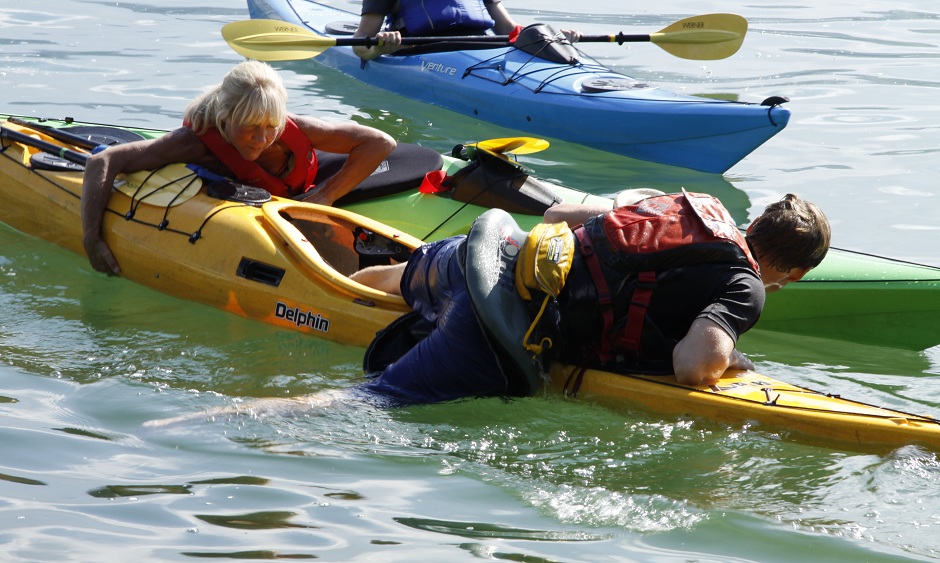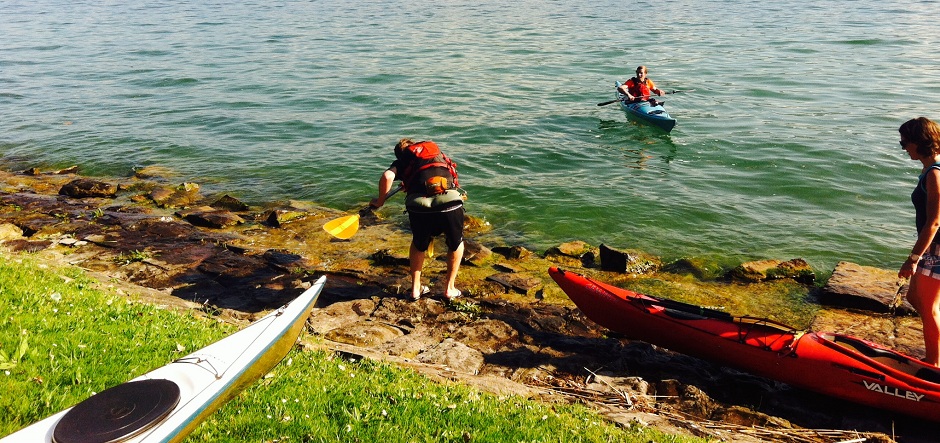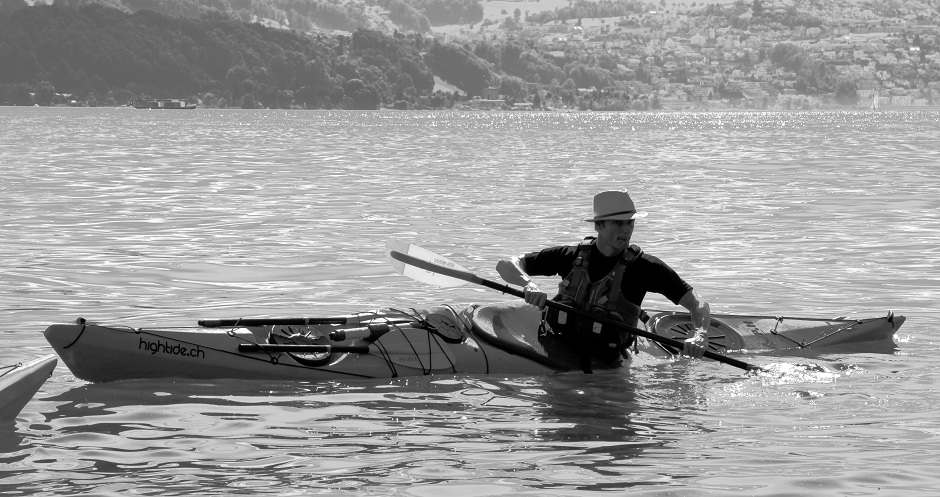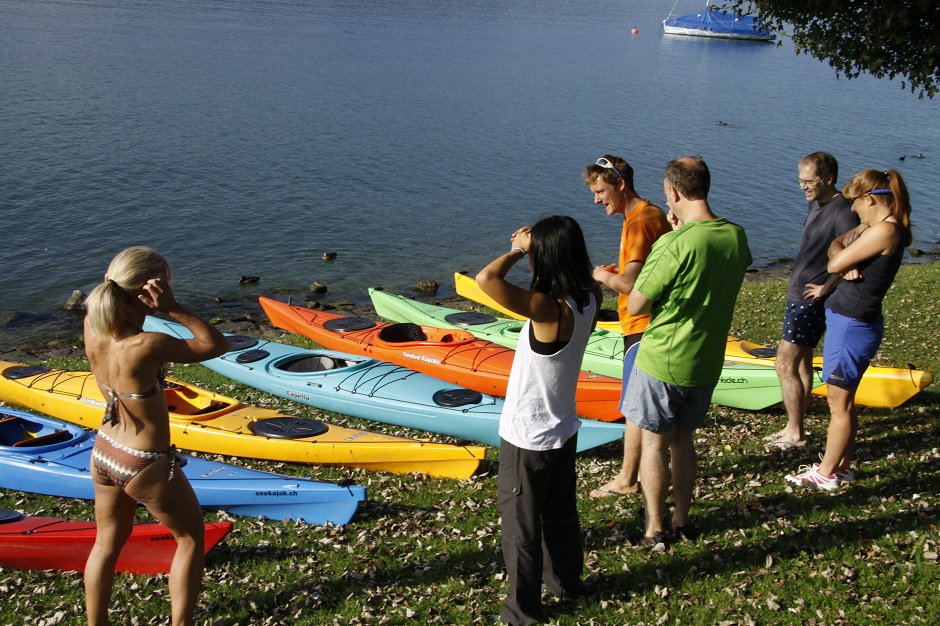Kayak Around Europe
More Than a Journey Around Europe
Rescue Course
I’m sitting at the computer and browsing adverts for secondhand kayaks. I want to buy a kayak for training. That’s because the manufacturer, with whom we had agreed on producing two boats for our journey, didn’t deliver what he had been promising for months he would. So we need to look for a different manufacturer…
…This time, however, it’ll be outside of the Czech Republic.
It’s been a half of a year since I looked for kayaks in Switzerland the last time. To my great joy, I’ve just discovered a new sea-kayaking school HIGHTIDE and not very far from me. I’m thinking: ‘That’s amazing!’ and my excitement gets even bigger because at the moment they’re having a kayak sale and they’re offering a participation on a kayaking trip on the sea. Well, how about training on the sea in Italy? I’m setting a meeting immediately.

The meeting with the owner of the school and the instructor in one person (Dave Storey) was full of positive energy right from the beginning. Dave comes from England, and since it’s a well-known fact that English kayakers belong among the best ones in the world I’m sure that I’ll be able to learn a lot from him.
Happily, he showed me all the boats and I told him about our plan to kayak around Europe. He couldn’t hide his thrill from my interest in joining the trip to Italy in order to gain some new experience directly on the sea. He offers me the last free spot on the list of participants (but from his enthusiasm I can tell that he would probably be able to create the spot regardless of the full capacity).
He also tells me about a rescue course which will run the following weekend on the lake Zurich, and he recommends me to participate as well in order to prepare for the sea. Then he apologises that he needs to do some work and has to leave. Before he goes he points at the boats and says that I can choose whichever I want and go for a paddle. Then he leaves with the following words: ‘Would you like to borrow anything else? When you’re done paddling just put the boat back, I’ll leave it unlocked here.’ (I have to say that this happened after a five minute meeting and that he lent me everything for free.)
As I’ve already mentioned the rescue course took place at the Zurich lake. I had been preparing to go there for some time before not only because of kayaking but also to check out conditions for diving. A successful freediving community has been gathering around the lake and it was there they broke a new Swiss record in this discipline not so long ago, the depth of about 70 meters. It gives me chills just to imagine how dark and cold it must be in such a depth. Especially, when I experienced it myself that sometimes light doesn’t go deeper than 20 meters and it starts being pitch black already.

Anyways, the practice of various rescue techniques, simulations of different accidents and their solutions either individually or in group was truly useful. One of the last techniques practiced (partially only voluntary) was the turning of a flipped kayak, or the so called Eskimo roll. This technique is used when the boat happens to be bottom up and it allows you to surface again without the need of getting out of the boat. This was the moment I was most looking forward to, although it was only a getting-to-know the technique of performing it. Still, I was determined to bring home my Eskimo roll premiere.
I had heard a theory before that claims one can accomplish the roll intuitively within a few minutes. If, however, this doesn’t happen then it’s most likely they’ll have to go through many hours of training. Dave also told me that he had never seen anyone who’d be able to manage the whole roll without quite a long training, nevertheless this didn’t take my determination away.
I’m attentively listening to Dave’s theoretical explanation and I’m trying to remember every move he’s demonstrating above the water. It looks easy, even when he shows the roll as an example.
So, here comes my moment. I breath in and start leaning over the side of the kayak only to find myself suddenly under the water and head down. I did a proper breathing warm-up, so I know I have enough time and I can calmly focus on the right execution of the roll. My eyes are closed and I’m trying to remember each move I saw when still above the water. But it’s harder than I expected. Everything is upside down and the mirror orientation is making it all even more difficult.
At once, I’m not sure what’s left and what’s right. Finally, I decide for the left side and I go for action, but every attempt ends sooner than it begins. Slowly, I’m getting out of breath, so I’m trying everything I can. I’m able to peek above the water a few times, but it’s all rather accidental and so fast I don’t have a chance to catch my breath. It’s been taking way too long and it’s high time to resolve the situation. I find the release strap and I drag myself out of the boat. Clearly, this attempt wasn’t a success.

Still, I’m not giving up and once I get back in the cockpit I receive some new instructions and advice. This time it’s much better. Being head-down was no surprise, so I lose no time before lining my paddle along the kayak. I make a half circle with the paddle and I heave myself up just in the right moment. It’s working, but I didn’t put in enough strength and I fall back into the water. I line the paddle once more and this time I give it all I can. Great! I shoot out of the water like a migrant salmon.
However, I didn’t really think about how to stop once I’m up again. Spinning, I continue back under the water at the other side of the boat. I didn’t count on this and I try to orientate quickly. Soon, I have to reach for the release strap again and drag my body out of the boat while still underwater.
For the third time I prepare thoroughly for all possibilities. Being head down or the change of sides of the turn won’t put me out of place any more. I straighten the paddle and start nice and easy. With each attempt I add a little more strength. When I manage to find the right balance of energy put into the manoeuvre I finally stop the turn on the surface. Hurray! I’m out of the water!
It’s an amazing feeling. Overjoyed I plunge back under the water to repeat the whole thing. But after a few unsuccessful attempts I have to swim out of the boat again. Nothing doing. One small victory is enough for me and I swim back to the shore exhausted. Although I managed to do the full turn only once I still receive an honest congratulation: ‘You’re the first one I’ve ever seen making it only after a few minutes.’ Dave remarked.
Those words warm my heart even though I’m thoroughly drenched and frozen. Now I only have to work on the right technique. Thanks so much for excellent instructions.





Leave A Comment